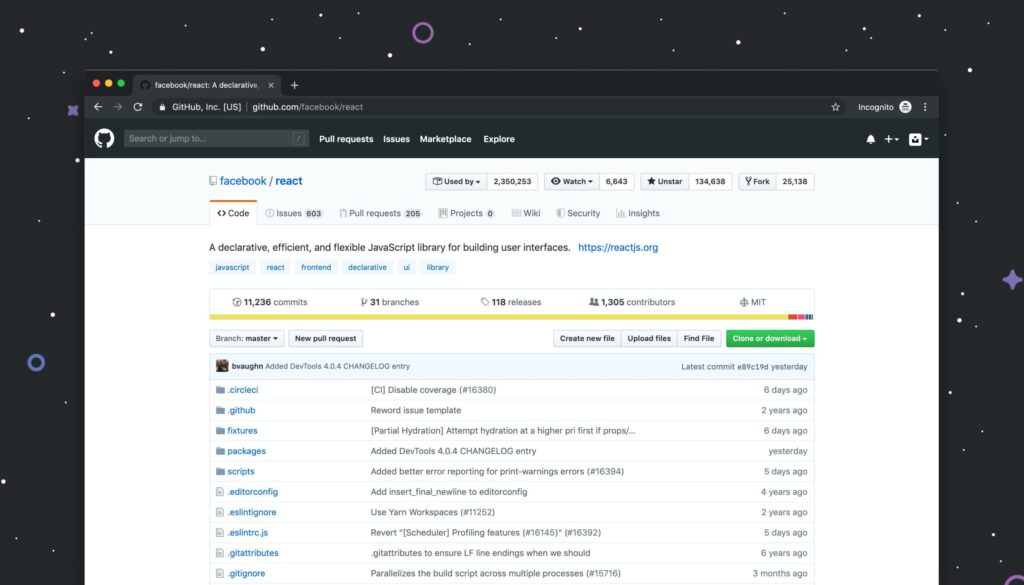
Git: A Complete Beginner’s Guide

Git is one of the most widely used technologies in the world. Practically anyone who programs is familiar with the tool, and most developers have leveraged it in some capacity at one point or another. Created by Linus Torvalds in 2005, Git is an open-source version control system, the most popular tool of its kind today. So, what is it all about? And why should you use it?
What is Git?
To start, a brief Git definition: Git is a free, open-source version control system that is distributed.
But what does that really mean?
With Git code history is tracked and stored. When you alter your project in any way, Git will keep a comprehensive record of your changes, so you will be able to see a full history of your work. You can also revert back to different versions or states of your project if need be. Whether you want to debug your code or view everything you have done, Git will make it happen.
The Git workflow has three states. In the working directory, you are able to make changes to your files directly. In the staging area, as you might guess, you can stage and prepare your files. And in the repository, you will store your snapshots.
Some of the top benefits and features of Git are:
• Smooth collaboration — contributions and changes from multiple developers can be merged
• The ability to view past versions of your code locally — files and all code are stored on your device
• Facilitation of easy communication and teamwork among developers
• Free and open source
• Non-linear development support
• Easier branching
• Scalability
• High performance and efficiency
• Quick to learn and use
• Smooth context switching
• Experimentation facilitation
• A high degree of flexibility
• Support for merging
• Accommodations for projects of all sizes
• Maturity
• Data integrity
• Compatability with other systems
• Excellent security
• A distributed architecture
• Ability to move back and forth between branches without disruption
Version control explained
Now you know that Git is the most ubiquitous version control system. But what, exactly, is version control?
Version control allows software and web developers to track, organize, and manage changes and alterations to the code within a specific project. Through features like branching and merging, developers can maintain a history of all iterations of the project, allowing them to revert back to past versions of the code without any disruption to the rest of the project. Or, you can go back to a previous version entirely.
This allows developers to work on a project simultaneously, as we have underscored with Git, as well as manage large projects as they grow in scale. You won’t have to worry about losing your work or otherwise disrupting the project flow.
What is GitHub?
GitHub is a for-profit organization that, at its core, hosts Git repositories. It is a cloud-based service, the most well-known and popular of its kind. However, there are some alternatives to GitHub, such as GitLab, Gitbucket, Bitbucket, and Phabricator.
As of July 2022, GitHub boasts a community of more than 83 million developers, more than 4 million organizations, and more than 200 million repositories. The Git platform allows developers to collaborate, build, scale, secure, and otherwise manage software projects.
GitHub is considered highly user-friendly, so much so that beginners are readily able to tap into its many features. But developers of all levels of experience leverage the versatile service. In fact, some individuals store and manage projects that are entirely unrelated to software development on GitHub!
GitHub also simplifies the process of using Git. Using the platform, you are better equipped to store and utilize your code and projects. But GitHub’s features extend far beyond offering the ability to manage Git code.
GitHub has an extensive community, allowing you to give and ask for advice on projects and code. There is, for example, a dedicated Discussions space where you can converse with fellow developers from all over the world. It is also, in many ways, a social networking site, specifically targeted to developers, allowing them to connect and find common ground over code and resource sharing.
You can sign up for GitHub and begin working on your projects on the platform for free. The space itself is not open source, but it allows you to collaborate on open-source and other projects within it. Many businesses and individuals leverage the platform for this very purpose. There are also paid plans — GitHub sells hosted private code repositories and additional services.
Why should you use GitHub?
By now, you probably understand the many benefits of GitHub. It is by many measures the largest programming community in the world — bringing developers of all kinds together. It’s an ideal platform for managing many different types of projects. It also offers an intuitive, accessible, web-based graphical interface.
If you are looking for strong project management capabilities, efficiency, security, and the ability to collaborate seamlessly, GitHub is the obvious choice. You can keep all your work in one place while successfully managing your team and your projects, no matter what their size, shape, or level of complexity. Plus, it will facilitate better coding — as well as hosting.
Outsourcing with Nearsure and Git
Are you looking for help with your next software development project? Continue your professional development and work with top experts in the industry thanks to Nearsure. Our staff augmentation services allow you to expand your team and complete complex projects with talented professionals filling in the gaps. Thanks to our remote-first model, developers are able to work with you from anywhere in the world.
Using Git and other tools, we will collaborate with you to ensure teamwork, efficiency, and productivity. And Git is just one of the technologies these professionals have in their repertoire. They will also leverage their vast knowledge base and high level of proficiency across numerous technologies and methodologies to ensure your project is completed efficiently and to your satisfaction. Learn more about our recruitment process and approach.




